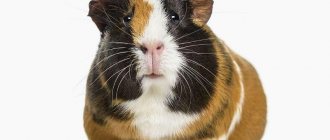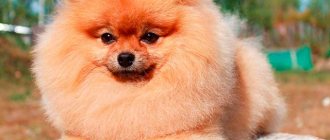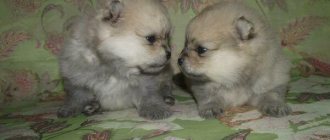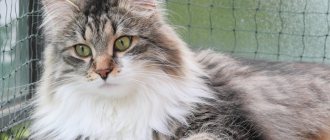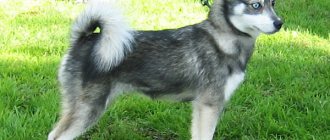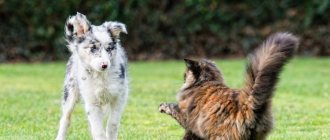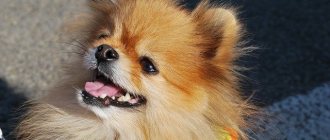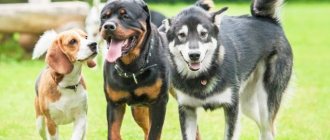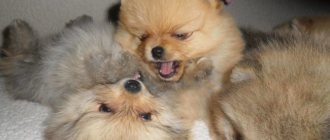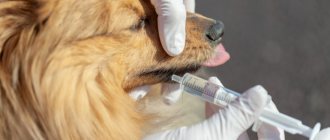History of the origin of the breed
Spitz are a group of very ancient breeds. Fossil remains of peat dogs in Switzerland and Lake Ladoga, ancient Greek and Roman images are similar to them. Spitz-like dogs were also found in Asia (Ur, China) and Africa.
The first Spitz came to England in the second half of the 18th century, but they became popular (especially those colored sandy and orange) in 1870, and from that time they began to be selected in order to achieve a reduction in size and enrichment of the “fur coat”. The dogs became more and more similar to modern Pomeranians. This was Marco, Queen Victoria’s favorite Spitz, with whom she was never separated. In 1891, the English Queen Victoria Pomeranian Club and the English standard were created: small stature and ears, light bones, very short muzzles, excess undercoat.
Following the British, the Americans began to work in the same direction. White dogs, which are still called “Eskimo Spitz,” became widespread among them. The American Breed Club appeared in 1909. Dogs that meet the American standard (compact, relatively heavy, intensely colored) are considered the best.
Russian and American dog breeders have long called Pomeranian Spitz simply dwarf, or miniature Spitz. They received their original name from the toponym “Pomerania” - a historical region of Germany.
French and German Pomeranians have an elongated muzzle, they are larger, lighter and “worse” dressed: there is no “collar”, there is not enough undercoat. The German association "German Spitz" was created in 1899. In it, the entire group of breeds was standardized by color and size.
The ICF classification classifies the Pomeranian Spitz into the category “Spitz and primitive type breeds.” The same organization considers Poms to be only a subspecies of the German Spitz, in contrast to the American Kennel Club, which claims that Pomeranians are an independent breed. The Russian Kennel Club operates according to FCI standards; at domestic exhibitions these dogs are called “German Spitz”, so we will continue to talk about the Pomeranian Spitz of the international (Russian) standard.
Miniature Spitz and Pomeranian: are there any differences?
The official name of the breed is Miniature Spitz/Pomeranian, or German Miniature Spitz.
Various international standards establish the differences between the Miniature Spitz (dwarf) and the Pomeranian. Thus, according to the AKC standard, an orange can be from 18 to 28 cm in height.
And the FCI standard establishes the division of oranges into breeds by height:
- Kleinspitz (small) - height 23-28 cm;
- dwarf (Zwergspitz) - 18-22 cm in size.
But these are all Pomeranians.
Learn about the varieties of Spitz breeds, as well as the keeping of Pomeranian Spitz, Japanese Dwarf Spitz, Italian Spitz.
Therefore, in one litter there may well be puppies that can be classified either as miniatures, or as Pomeranians or Kleinspitzes.
And of course, everything will depend on the standard of the canine federation according to which the qualification will be carried out.
Did you know? The Miniature Spitz, owned by Elizabeth Barrett Rothschild, was one of the few dogs to survive
"
Titanic
"
. He and his owner were accepted into boat No. 6.
Description of the breed
Colors of oranges
Spitz are classified as dogs of the so-called fox type; Pomeranians are the smallest representatives of these breeds.
- plain (black, cream, chocolate, white, orange, blue),
- non-monochromatic (black and tan, zone gray, blue and tan, two-color, sable),
- chinchilla
Any variants with a blue suit are outside the standard.
Breed standard
The Pomeranian is a “square” dog: the body proportions are 1:1, that is, the height and length are the same..
Head:
- the muzzle is twice as long as the skull,
- the nose is black or brown (in chocolate ones),
- lips do not protrude, black or brown,
- full set of teeth, scissor bite,
- Small triangular ears are erect and set high.
Torso:
- the back is straight, the shorter the better,
- the loin is strong, wide,
- the tail is heavily pubescent, high, thrown over the back, a double loop at the end is acceptable,
- the chest is arched, its front is well developed,
- the croup is wide, unmown,
- the stomach is moderately tucked.
- the skin is adjacent to the body, does not hang.
Legs:
- the forelimbs are strong, erect, with well-developed muscles,
- the shoulder blades are long, forming a right angle with the shoulder,
- paws are small, collected like a cat, claw pads are black or dark brown,
- the hind legs are muscular, with thick “pants” up to the tarsal (hock) joint,
- joints are strong,
- the paws are less round than those on the front legs.
Wool:
- double: long guard hair that holds the vertically “whipped” short undercoat,
- straight, long (except for the muzzle, ears, front of the legs and paws),
- a mane on the neck and shoulders, “pants” on the hind legs, a woolen whisk on the tail.
Varieties
Pomeranians are classified as miniature spitz (18 - 22 cm at the withers). There are types:
- “Fox” - a classic Pomeranian Spitz with an elongated muzzle (3 - 5 cm) - complies with the breed standard according to FCI and RKF,
- “Bear Cub” - a dog with a short muzzle (less than 3 cm) - meets the AKC breed standard.
This classification is unofficial, but for some reason the bear type of Pomeranian is becoming more popular every year both among dog breeders and among exhibition expert judges.
But selection towards ever shorter, bear-like faces harms the health of the individual dog and the entire population as a whole, leading to the degeneration of the breed!
Classes
Different puppies are born in the same litter. The characteristics of each determine its quality, according to which the dog is awarded a class: show, breed or pet. A breeder can give a guarantee for a high class (show, breed) only for a grown-up (adult) dog over a year old, which has demonstrated all the inherent qualities and has already proven itself in the ring. It makes no sense to assign classes to puppies: they change with age, but an experienced breeder can determine the show potential of an animal from 2 months.
- Show class: full compliance with the standard in appearance and character, advantages outweigh minor shortcomings, excellent pedigree; desirable for breeding.
- Breeding class: good heredity, shortcomings (not vices!) do not interfere with exhibiting, but do not count on prizes; Poms of this class are mainly females, they can be bred, but only with show dogs.
- Pet class: purebred dogs with a simple pedigree, noticeable or invisible defect (cryptorchidism, malocclusion); not suitable for breeding and exhibitions.
What do German Spitz look like?
This breed has a long history, and its ancestors include the turf dog, which lived during the Stone Age. At first, German Spitz were "working" animals. It was easier to keep such ringing guards than large dogs, and their loud barking always warned in time of the approach of strangers. Over time, aristocrats also paid attention to the cute animals. Well, now representatives of this breed are real companion dogs with their admirers all over the world.
Spitz are proportional, medium-sized dogs. Photo: Lenkadan/Depositphotos
The body of the German Spitz GERMAN SPITZ is proportional. The head is medium size. Wide at the back, it tapers into a wedge shape towards the nose. The muzzle is not too long. The eyes are medium-sized, almond-shaped. The ears are small, erect and pointed, set high and quite close to each other.
The neck is of medium length. The back is strong, short and straight, the loin and croup are short and wide. Chest with well developed forepart. The high-set tail is of medium length.
The size and height at the withers depend on the subgroup:
- Wolfspitz (Keeshond) - 49 cm ± 6 cm;
- large (grossspitz) - 45 cm ± 5 cm, medium (middlespitz) - 35 cm ± 5 cm, small (kleinspitz) - 27 cm ± 3 cm;
- dwarf (Zwergspitz/Pomeranian) - 21 cm ± 3 cm.
Weight also varies and must correspond to the type of subgroup.
All German Spitz dogs have a lush coat, with a soft, short, dense undercoat and long, straight, coarse guard hair. On the head and ears, on the front side of the limbs - velvety, short and dense. Around the neck and on the shoulders, these dogs have a rich “collar” resembling a mane, on the back of the hind legs there are lush “pants”, and the tail is also fluffy.
The typical color for a Wolfspitz is zone-gray; other Spitz dogs come in black, white, brown and more.
Take note
